After visiting Ne Castle in Hachinohe in the early morning I rushed to my train to get to the Shimokita Peninsula, having the typhoon right behind me. Unfortunately the trains weren’t running anymore at that time and buses were provided instead. The buses were much slower than the trains and so I also missed the bus connection to my next destination: Osorezan aka Mt. Osore … 
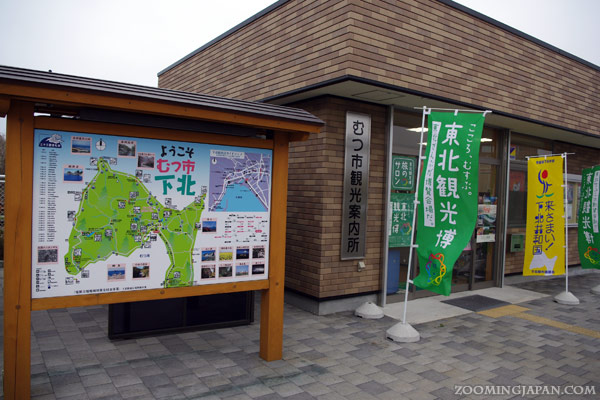
In front of JR Shimokita Station in Mutsu City I was waiting for the next bus to go to Mt. Osore.
It was gray and cloudy, but there was no rain or wind yet, so I didn’t understand why they already stopped the trains. Mutsu City Tourist Information Center is right next to the station. You’ll get all the information you need as well as a map of Osorezan.
The buses leave right in front of the information center. There are also a few coin lockers.
Visiting Osorezan – The Gateway to Hell

Mt. Osore (恐山) is one of the most sacred places in Japan along Kansai’s Mt. Koya and Mt. Hiei.
Osorezan (恐山) literally means “terrifying mountain” and is considered to be the gateway to Hell. If you have a look at the landscape of volcanic wasteland, howling winds and bubbling sulphur pit, you’ll understand where this is coming from. The nearby Lake Usorisan is considered to be a gate that deceased souls need to cross on their way to afterlife.
Mt. Osore is not an actual mountain (879 m), but a caldera volcano in the center of the remote Shimokita Peninsula (下北半島) in Aomori Prefecture. The last eruption was in 1787 according to the Smithsonian National Museum of National History.
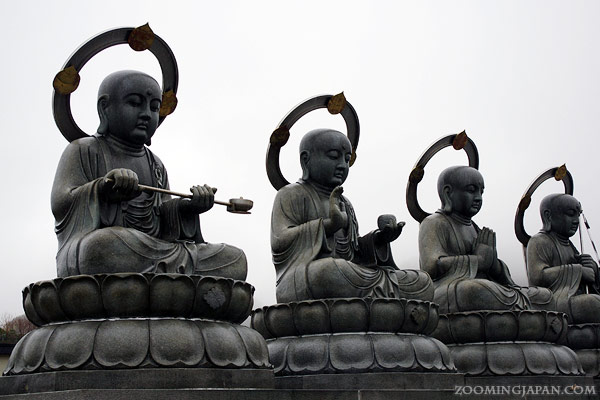
Attention:
You can only visit from May 1st to October 31st!
After that the harsh winter makes it impossible for tourists to access.

Bodai Temple (菩提寺) offers temple lodging and an onsen for visitors.
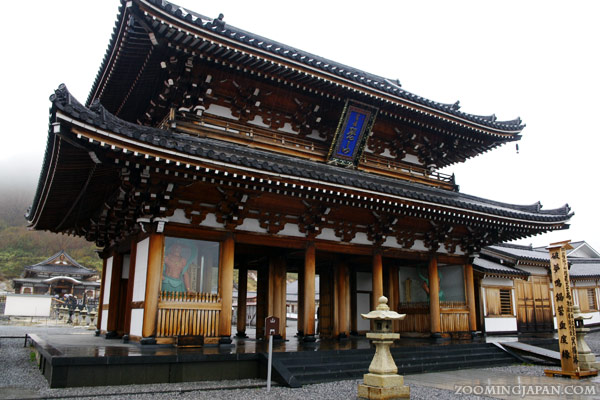
Despite its remoteness it is a very popular and well-known destination.
From July 22-24 the Osorezan Taisai (恐山大祭) is held. People who want to communicate with lost loved ones attend.
Mediums known as Itako (イタコ, traditionally they were blind women, nowadays many are not) who have undergone extensive spiritual training will try to communicate with the dead. They have to perform purification rituals for 3 months before the actual event starts.

As you can see the weather was already quite horrible when I arrived. It started raining and it was windy.
The typhoon was almost there.
At least the weather made it feel like this was really the “gateway to hell”!
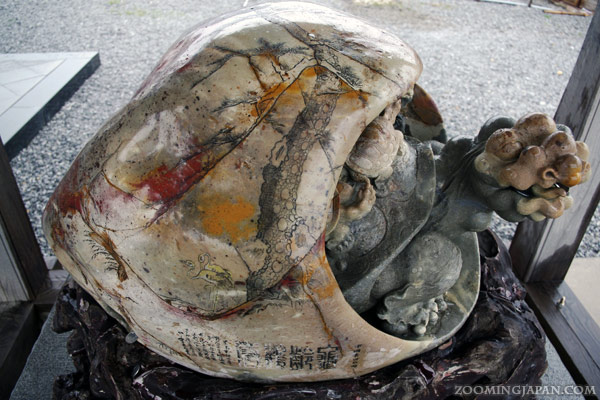
A very weird turtle monster (?!) stone statue.
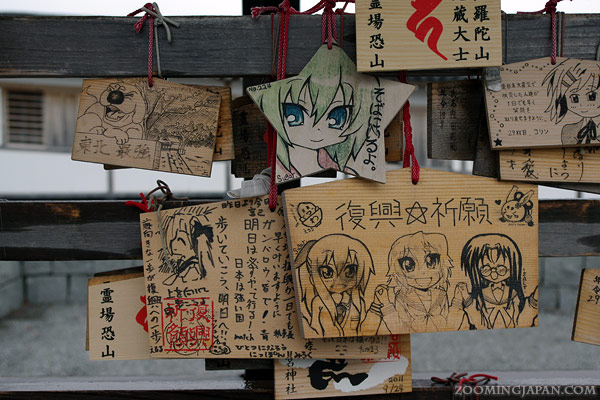
A lot of manga figures were drawn on the ema of the temple.
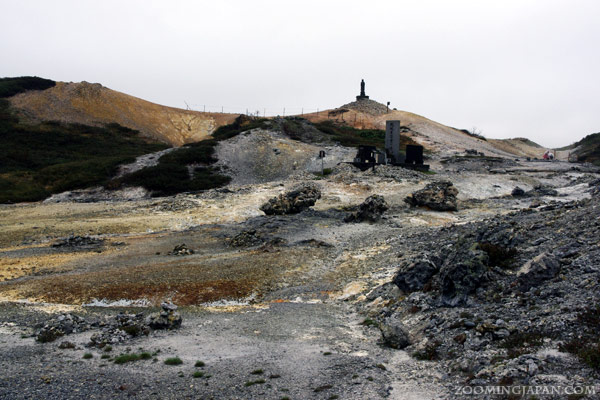
Right behind the main temple facility you can start your stroll through the volcanic grounds of Mt. Osore.
It’s a very spacious and unique landscape that awaits you!

I recommend taking your time as there are so many things to discover like these little Jizo statues hiding somewhere in or between the huge volcanic rocks.
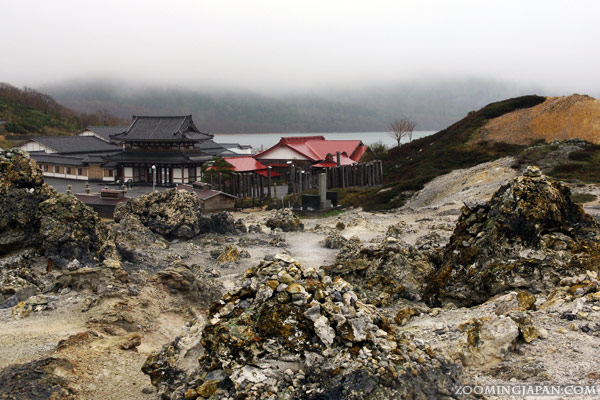
There are millions of Jizo statues everywhere!
Jizo (地蔵) are the guardian of children and the bodhisattva of Hell. They protect the site.

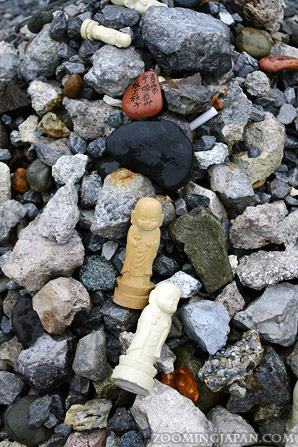
As mentioned earlier the nearby lake is considered to be a gate to afterlife (Sanzu no Kawa, 三途の川).
The souls of dead children and unborn babies try to cross the river. This “limbus infantium” is represented by piles of pebbles along the riverbed (Sai no Kawara, 賽の河原).

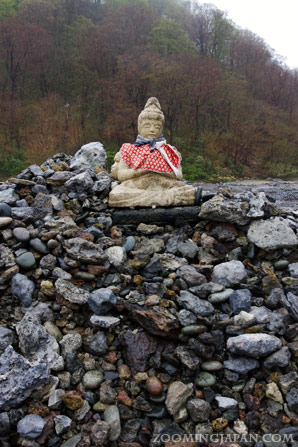
The Jizo protect the souls from evil demons that try to destroy those piles of pebbles.

The Jizo needed to be protected from the rain, too, I guess.

As the Jizo are the guardians of the children’s souls you’ll also find a lot of toys and other typical items for children such as colorful wind wheels.

In the background you see Lake Usorisan (宇曽利山湖) that the dead souls are supposed to cross on their way to afterlife. Close to the riverbed there were a lot of stones and statues.
It was a very unique sight!
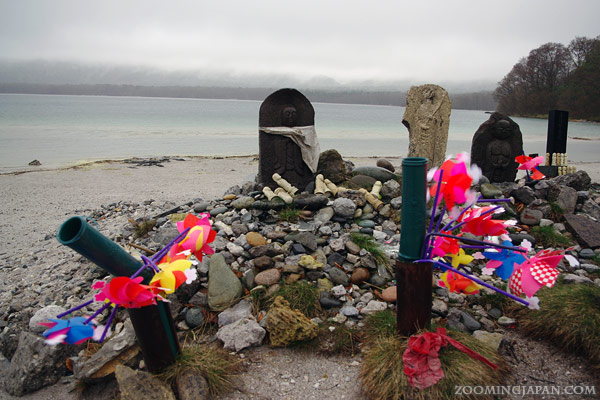
I hope the Jizo are able to protect the children’s souls on their way across the river.

I’m sure the atmosphere would have been completely different in good weather.

It really has a very special atmosphere to it that you should experience yourself.
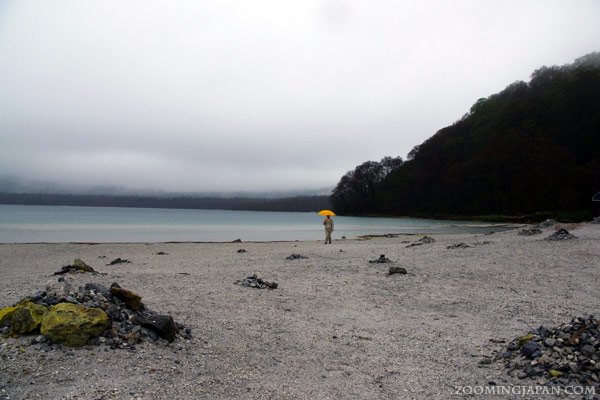
Did I just spot a lost soul? ….
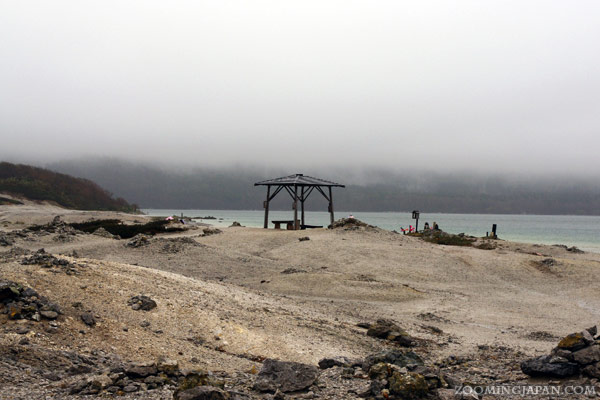
The area along the riverbed is actually really quiet and peaceful.
While the river looks quite beautiful and a stroll along the riverbed can be nice, the water is poisonous, so you shouldn’t take a bath in there!

This “dude” was completely wrapped up!

It started raining really hard and I felt sorry for the Jizo, but I’m sure they still did a great job protecting the children!


Such a cute wind wheel!

The weather got more and more uncomfortable. The typhoon had finally arrived.
At that point I was completely soaked! Keep in mind that Tohoku in May is still very cold.
Being completely wet in cold weather is not the best idea, but what can you do?

I tried to hang in there. There was still some time left until the next bus would come and I was already wet anyways.
I wanted to see more of the beautiful and unique landscape.
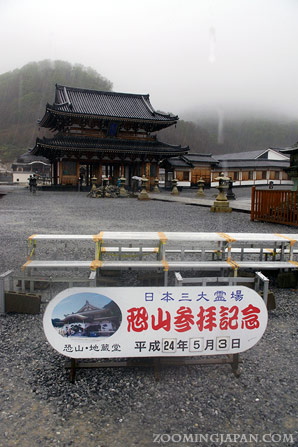

Extremely strong rain. It was difficult to take decent photos.
You can see the date displayed on the sign: May 3rd 2012 (Heisei 24, 平成24)
People can take a photo of themselves there, but I doubt that anybody wanted to in that kind of weather!
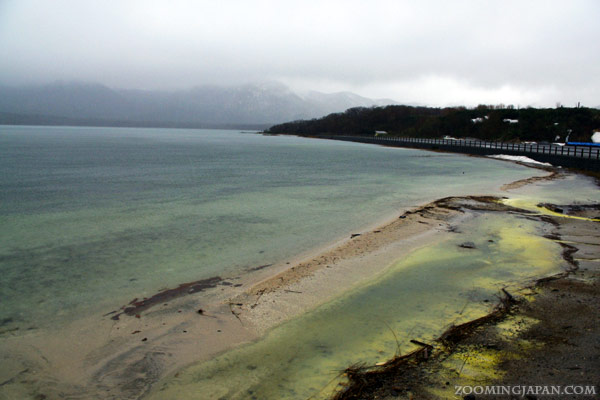
I had a few more minutes before my bus would come, so I rushed along the river (outside of the temple facility, near the parking lot) because the colors of the river were so beautiful despite the bad weather!
The different colors are caused by the river’s high sulfur content.

This bridge with the river in the background is a very popular spot to take photos.
At that time it was the end of the world, so I couldn’t get a nice shot, but you can google it to see how beautiful it is in good weather!

That style of bridge is called “Taiko Bridge” (太鼓橋) in Japanese.
It is said that bad people cannot cross the bridge as they’ll just see a mountain of needles instead of the bridge.
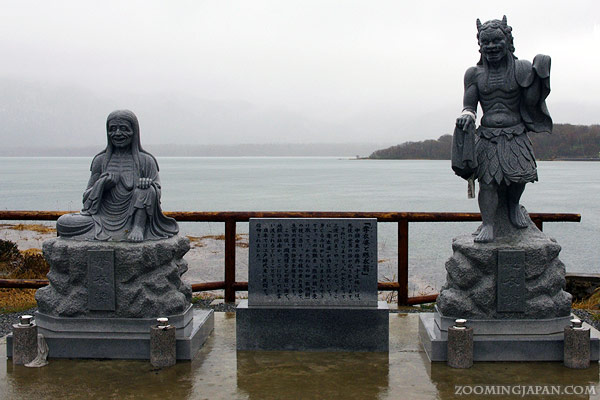
These statues are right next to the bridge.
I had to rush back to catch my bus.
Back at the Shimokita JR Station the trains were running, but with delay. I had to wait for over an hour, sitting around in soaked clothes, freezing like hell. It’s a wonder that I didn’t catch a cold. .gif)
Luckily some nice Japanese people around me who had to wait as well, offered me their jacket and whatnot.
The train ride back took a long time, too. My clothes were almost dry by the time I arrived at the coin locker were I had my suitcase.
After changing clothes and drinking something hot, I was off to Aomori City.
You could also go by taxi from there, but that would cost around 4000 yen.




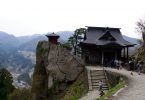
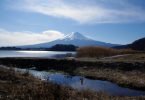

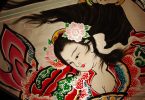
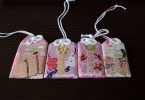
Certainly a very interesting landscape, but rather spooky and a bit depressing. No doubt made more so by the weather at the time. It reminds me somewhat of the “hells” near Unzen on Kyushu.
I do like jizo statues, though of course the connotation is sad.
You comments about being soaked make me wonder if you are properly equipped for rain, which you should be, given it rains so often in Japan. I would have gone there with boots, preferably rain boots, a good raincoat with a hood [given the wind, an umbrella wouldn’t be ideal] and pants sprayed with waterproofing. British people actually wear “rain pants”on top of theirs, but I don’t think one needs to go that far.
As you know I visited Mt. Unzen as well and my impression of it was different from the one here.
I think the weather also had to do with it, but it was not only that.
Mt. Osore has a mysterious atmosphere. Mt. Unzen reminded me more of Beppu.
Believe it or not, but I’m always equipped well. I don’t have rainboots, but apart from that I have rain trousers, a raincoat and even rainsheets for my backpack, camera etc.
The wind was so strong, that an umbrella couldn’t be used at some point anymore and if it rains REALLY hard than I usually get soaked through my anti-rain clothes.
It doesn’t rain so often in Japan (apart from rainy season). I just ran into many typhoons this year. Actually we had too many typhoons this year, even outside of the normal season.
Sounds like an amazing place. Definitely adding it to my list of sites to visit in Japan!
I hope you get to go one day! ^__^
Thanks for sharing your experience in this place.
Mt. Osore is an interesting place rich with history. Sacred place it is! :stars: :thumbup:
Being caught up in a typhoon on your travel might felt horrible. Good thing you didn’t get sick. You could only wish it won’t happen to you again while traveling. :rainy:
I was caught by typhoons a lot this year. We had far too many anyways – and outside of the normal season as well. Apart from my summer vacation I was hit by a typhoon during all of my trips since early April. Very annoying! :/
Thanks for sharing another great place with us. I didn’t know too much about Mt. Osore, so really enjoyed finding out all about it. It certainly lives up to its name as the entrance to hell with the charred landscape and sulfur fumes from the volcano.
For me it really had a very special and unique atmosphere to it, so I highly recommend visiting it although it’s really far out, but that makes it an even more unique experience! ^__^
This is a place I would love to visit. Thanks for such a comprehensive post and, as always, wonderful photos.
I had never heard of mt. Osore before but now it is on my list!
The ema reminded me of a question I’ve always had about japanese culture. I notice that stars and peace signs (the action) are used often. It is always interesting to learn the why’s or how’s something became popular. ^_^
Hi, Just to check, how long does it take to travel from Aomori City to Mt Osore?
Do you cover Yagen valley/river as well?
I’m planning for a trip next year to Aomori so any information will be good :)
Thanks in advance!
Hello Janlyn! :)
I went from Akita City to Mt. Osore to Aomori City all in one day, so there’s nothing you should worry about. If you plan to do Mt. Osore on a day trip, then you’ll certainly have enough time.
As I went during a typhoon and couldn’t take the regular train which wasn’t running anymore but a bus instead, I can’t tell you how long it would usually take.
A train from Aomori to Shimokita Station (from where you take a bus) would take less than 2h! ^___^
Unfortunately I haven’t been to Yagen Valley.
Oh thank you for the wonderful post! MT Osore is so beautiful!!! And I guess the weather really gave its mysterious quality a boost!! How I wish I can visit there too during the coming Dec trip. But as you mentioned, it is closed during that period. T..T
I’m sorry to hear that you won’t be able to visit, but I’m sure you’ll enjoy your trip a lot nevertheless! ^___^
Such an eerie place but yet fascinating! It is going to be my next destination this year. I love volcanoes & mountains!
Then I’m sure you’ll love it there!
It’s really a special experience.
This is a wonderful blog ~ I enjoyed it so much ~ Thank you as always Zooming !
Thanks for your nice words! :)
An unbelievable and beautiful color combination that is. The photos seem almost surreal at a time, but that’s maybe because i don’t see most colors as others do ;)
It’s definitely one of the places i’m looking forward to visit one day and i hope there’s no shiny weather when i hit it. :mukatsuku:
I think in this particular case it really has nothing to do with you not being able to see most colors (what??!!) – that’s just how surreal the whole place really is! ;)
It’s called Deuteranopia ;)
Love the photos.. Though eerie but worth visiting. Hope that day will come soon.
I hope you get to go! ^_^
Thank you for braving the bad weather to bring such interesting photos!
Haha, you’re very welcome – and I’m glad I did it, though I’m tempted to go back during good weather one day. ;)
Thank you so much for this, with your directions it was very easy to go! I also went to Aomori and it was very helpful your other entry in the blog. Luckily, in Noheji Station I run into a delightful old lady from Kobe that dragged me here and there and took me to the train and the bus, we talked with a lot of old men and women visiting Osorezan and the lady in Noheji’s omiyage shop gave me some apple biscuits as a present because they were surprised I was traveling alone (I think they were more surprised because I’m from Argentina, it’s a little strange for them although we have a big Japanese community here). It was incredible and I feel so blessed that I could visit Osorezan. Thank you, again :)
I’m very glad to hear that. ^__^
Aww, it’s awesome you had such a great time interacting with Japanese people.
I’m not surprised she was from Kobe. Kansai people are especially extroverted. ^^
Thanks for taking the time to share your experience. :3